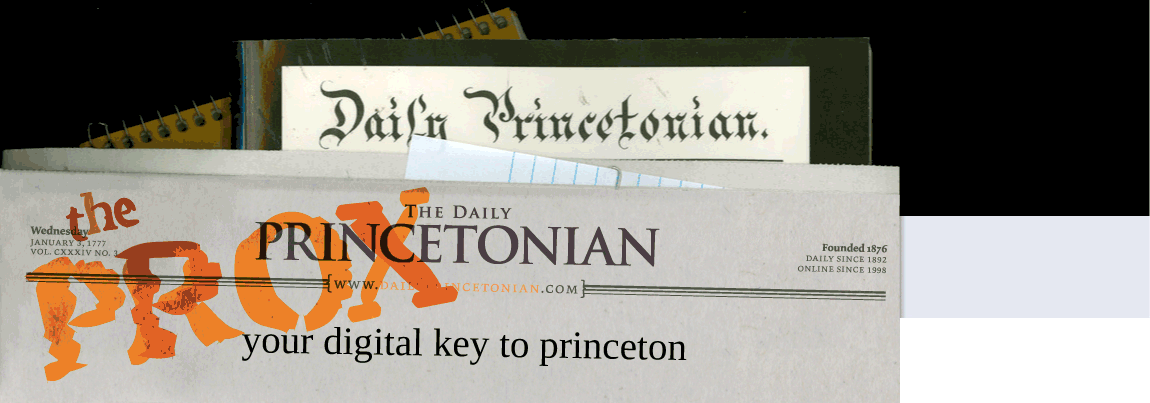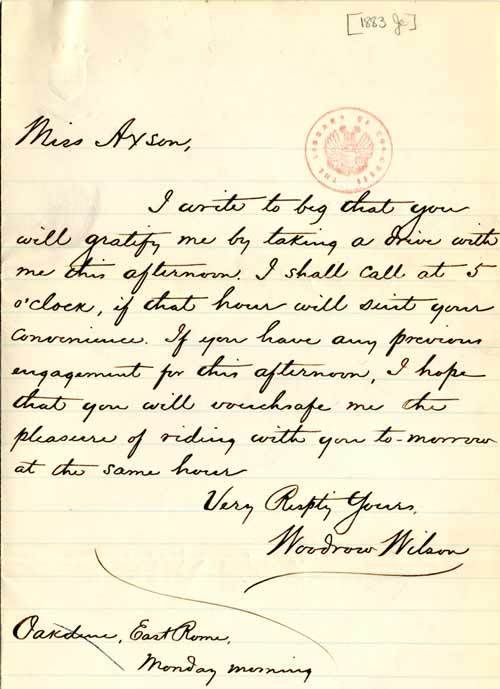Princeton will face national runner-up Johns Hopkins in the Konica-Minolta Faceoff Classic. The game will be televised starting at 12 p.m. on ESPNU. The Tigers were soundly defeated by the Blue Jays last year. While the final score was a seemingly respectable 14-9, the halftime score was 10-1 and Princeton never mounted much of a comeback.
Friday, February 27, 2009
Tiger Watch: What Vikram Rao Thinks about Men's Lax, and a Little Bit of Hockey
Princeton will face national runner-up Johns Hopkins in the Konica-Minolta Faceoff Classic. The game will be televised starting at 12 p.m. on ESPNU. The Tigers were soundly defeated by the Blue Jays last year. While the final score was a seemingly respectable 14-9, the halftime score was 10-1 and Princeton never mounted much of a comeback.
20 Sweet: Rainy Day Songs

On a day with today’s forecast, I suggest not even bothering to search for the umbrella; it probably got lost under the futon months ago.
Instead, I propose a lazy Friday.
Stay inside, put on the sweats, listen to these tunes, kindly ask your roommate to bring you some meals, and soak up the rainy day…without getting wet at all.
Enjoy, and remember that your favorite rainy day music suggestions are always welcome!
1. “Two Coins” – Dispatch
2. “Our House” – Crosby, Stills, Nash & Young
3. “Naked As We Came” – Iron & Wine
4. “Lover, You Should’ve Come Over” – Jamie Cullum (Jeff Buckley cover)
5. “The Rain” – k-os
6. “Sea Green, See Blue” – Jaymay
7. “Lay Lady Lay” – Bob Dylan
8. “Those to Come” – The Shins
9. “In the Air Tonight” – Phil Collins
10. “Somewhere Over the Rainbow” – Israel Kamakawiwo’ole
11. “Don’t Leave the Light On Baby” – Belle & Sebastian
12. “Misread” – Kings of Convenience
13. “Turn Your Lights Down Low” – Bob Marley & The Wailers
14. “Hold You In My Arms” – Ray LaMontagne
15. “Secret Garden” – Bruce Springsteen
16. “Skinny Love” – Bon Iver
17. “The Rain Song” – Led Zeppelin
18. “Lover Lay Down” – Dave Matthews Band
19. “After Hours” – Velvet Underground
20. “Fire and Rain” – James Taylor
Edit: Well, looks like we got lucky and the weatherman was wrong about this whole rain thing! Nonetheless, what beats a Lazy Friday? Take one anyways--these songs work on grey/slightly drizzly days too.
Thursday, February 26, 2009
The Economic Downturn
Wednesday, February 25, 2009
Going Clubbing: Found in Translation
 Sick of dining hall food? Perhaps you’d prefer the “red beet soup with cheesy dumplings in the form of fingers” one Polish hotel proudly offers. Or maybe some Swiss wine that would “leave you nothing to hope for”?
Sick of dining hall food? Perhaps you’d prefer the “red beet soup with cheesy dumplings in the form of fingers” one Polish hotel proudly offers. Or maybe some Swiss wine that would “leave you nothing to hope for”?
While such examples of translation gone horribly wrong can be found on the web in increasing quantities—often compiled by humor sites in an attempt to elicit a few chuckles—accurate translation is a more somber matter for non-profits around the world whose limited budgets leave no room to hire a professional translator. Fortunately for them, PULP is ready to help. (No, not the O.J. kind…) The Princeton University Language Project, in keeping with Princeton’s in-the-service-of-all-nations spirit, offers free translation services in more than five languages to charitable organizations based both in the U.S. and abroad.
Formed in 2005 by Eugene Yi ’08, PULP now boasts a mailing list of 400 students, with 25-30 volunteer translators regularly attending the group’s Friday afternoon translation workshops. Some of these undergrads, says Lily Fu ’11, PULP’s newly-elected President, are native speakers, but as many more are not. Meghan Todt ’11, for instance, explained that she joined the group last year after finding that she could no longer fit Spanish classes into her schedule but still wanted to maintain the level of proficiency she had acquired over several years of language study.
When Fu assured me that PULP welcomes students of all fluency levels, pointing out that projects vary widely in terms of difficulty, I was at first skeptical. Let’s just say that if I, with my pitiful command of the Spanish language, were to attempt translation for real organizations, the results would not be pretty. Yet PULP is organized such that multiple students review each translated document before it is completed.
“The first draft is the hardest, and the most time-consuming,” said Fu, “but native speakers of the language always edit these preliminary drafts to ensure accuracy.”
It seems that their system is working. In its earliest years, PULP reached out to organizations it believed could benefit from its services; today the group is frequently contacted by companies who have heard about its work and seek translators for their own documents. Even Princeton has joined in, Fu notes: “Last year, we translated Orange Key’s online virtual tour, as well as documents for University Health Services.”
What’s next for the club? Fu mentioned that PULP plans to again sponsor an undergraduate translation competition in the hopes of generating campus-wide awareness for the group. She’d also like to expand PULP’s language base: while translators work on a consistent basis in Chinese, Spanish, Korean, Japanese and French, there is always a need for additional languages.
For now, however, PULP will continue to “fight Engrish” the best way they know how, one non-profit at a time.
Tuesday, February 24, 2009
Moon-Walking Gorillas
While many people can safely assume that they would never miss a "moon-walking" gorilla in their presence, scientists believe that with the proper context, most people will miss the presence of the animal completely.
As part of an ongoing "Science on Saturday" series, Dr. Susana Martinez-Conde, director of the Laboratory of Visual Neuroscience in Phoenix, AZ, spoke to a packed auditorium of high school students and parents at the Princeton Plasma Physics Laboratory last Saturday.
In a talk titled, "Illusion and Reality: At the Boundary of Art and Science", Martinez-Conde explained how her lab's research is more frequently studying art in order to examine how the brain perceives objects. Martinez-Conde presented an interactive lecture, asking the audience to participate in a series of visual experiments and explaining the scientific processes behind the different classifications of illusions presented.
Many centuries ago, the philosopher Aristotle noticed that simply shifting his gaze from a waterfall to nearby rocks made it appear as if the rocks were also in motion. Beginning with the first known recognition of optical illusion by Aristotle, Martinez-Conde explained that many artists, including Leonardo da Vinci took advantage of the flexibility of the brain's optical nerve.
While displaying a photo of da Vinci's Mona Lisa, Martinez-Conde explained that the mystery and fascination behind the famous painting may lie in an optical illusion at the center of her smile that the artist created.
"Mona Lisa's smile changes -- we see a subtle smile because of how our neurons process visual information and the smile really becomes broader as it moves away from the center of our gaze," she said.
Martinez-Conde explained that it is categorized as an anamorphic illusion because of how the smile is drawn with low spatial frequency. Photons of light bounce from the image to our eyes and then travel through a visual pathway to photoreceptors in the eye. However, the focus and resolution changes easily, leaving many confused as to whether or not she is actually smiling and how wide her smile actually is.
She went on to explain that humans were unique from dinosaurs and frogs in that we are able to see moving objects. Even when humans focus their sight and believe their eyes are not moving, there are three different types of microscopic motions, microsaccades, drift and tremors, that occur in the eye. Using stabilization techniques in the lab, researchers discovered that if our eyes were kept completely still, like dinosaurs and frogs, we would be unable to see non-moving objects.
While presenting a series of illusions, such as adaptation illusions, illusory motions, ambiguous figures, and invisibility illusions, she allowed the audience to play the role of her research subjects. Many audience members reacted with verbal surprise when they realized how their perception of different images differed from the actual images on the screen. She also said that many scientists, including those in her lab, have begun working with magicians in order to better understand their techniques and how they affect our brain’s neural and visual system.
Martinez-Conde made a reference to a popular movie, The Matrix, to summarize her talk and explain how what we experience, like optical illusions, may just be our brain playing tricks.
"Nobody has put it better than the famous philosopher Keanu Reeves ... all of our subjective experience is a brain construct," she said.
On a side note: this is the 500th Daily Princetonian Prox Post. Many thanks to all of our readers!
--Tasnim Shamma '11
Tiger Style: The Oscars
Dear Mr. Klitzman, Again
The Daily Princetonian Sports Editors respond to a Daily Pennslyvanian blog post, which was a response to Daily Princetonian column, which was itself a response to a Daily Pennslyvanian column.
Dear Mr. Klitzman,
Well, this has been fun. It's been a while since we've been able to banter back-and-forth with a skilled verbal pugilist such as yourself. But this is the last thing we are going to say on the issue, partially because — as you said — it is foolish for us to even attempt an argument with someone who scored an 800 on the verbal section of his SATs. More importantly, though, we just don't care all that much about you, your basketball team or the rest of your athletic program.
There is no Penn-Princeton rivalry, and there will not be one anytime in the immediate-future. Why? Because you simply are not on our level. There is a reason Princeton has a bonfire each time our football team beats Yale and Harvard. And why the big Ivy League track and swimming meets are called HYPs. Yes, in case you are wondering, that P stands for Princeton.
Penn is largely an afterthought in Ivy athletics. Sure, your wrestling program is storied. And yes, you beat our sprint football team soundly every year. But, in measuring tradition – your word not mine – there is no comparison.
As for your "corrections" to our column earlier in the week, we felt the need to clarify a few points …
• The Prince does not use italics – not for publications and not for emphasis. If you find that unprofessional, we can give you the email address for our Board of Trustees, feel free to take it up with them. Just a suggestion: be sure to mention in your complaint that you got an 800 verbal on your SATs, that stuff really impresses here at Princeton.
• Our column never states that squash is an NCAA sport, or that the women's squash team's victory was an NCAA title. (How did you manage that 800 if you skipped the reading comprehension portions?) Had we made that mistake, we would have mistakenly said that we have 40 more NCAA championships than you, not just 18.
• And no, our analogy was not meant to imply that Penn "owns" the Tigers. Just look at the history of our two athletic programs. For someone who got an 800 verbal on his SATs, the analogy should be fairly clear.
• Correction: Penn basketball is 22-16 since Jadwin opened. But "Space Mountain" houses a lot of other sports. Ask your squash teams how it feels coming to Jadwin every year.
• As for your hockey excuse, we recommend you take a look at our men's team — it's currently ranked No. 6 in the nation. We do play hockey down here, YOU don't. Or, to be more accurate, you did. Until your varsity program folded a few years back. Sorry about that.
• Thanks for the link to maddox.xmission.com, but I prefer to take my writing advice from someone who doesn't write posts titled "the iPod is a piece of sh*t and so is your face." But you stick with it, it works for you.
• Your website said Tuesday's game was "one of the best Penn-Princeton games in years." Is sloppiness a prerequisite?
• I actually did mean Time, but you bring up a good point. Sports Illustrated thinks we're pretty damn good too.
So this is it. We're done. Feel free to respond once again, but you won't be seeing another one from us. We'll leave you with one final suggestion: Though you may feel the urge to respond, we suggest you instead engage that 800 verbal-brain into writing an apology to the founders of firejoemorgan.com. Their creation was too great to be bastardized by you in some petty column. Perhaps you should start like this…
"Dear Dak, Junior and Mr. Tremendous,
Even though I got an 800 verbal on my SATs, I am writing this email to apologize…"
Yours truly,
The Sports Editors of The Daily Princetonian
Sunday, February 22, 2009
Figures of Speech (and Art?)

When it comes to narrowing down all of the wild and fascinating lectures offered every week into three blurbs, sometimes I don’t even know where to start. This week’s attempt includes:
“Evaluating Climate Change Institutions: Justice or Legitimacy?” on Tuesday February 24, 4:30 in Betts Auditorium, Architecture Building – Continuing the Princeton Environmental Institute’s “Ethics and Climate Change” lecture series, Prof. Robert Keohane of the Woodrow Wilson School will explain why the idea of justice, a fluctuating moral compass that can never achieve universal uniformity, is so common in policy discussion but still almost entirely useless as a standard by which to judge the politics of climate change. Keohane will investigate the effectiveness of legitimacy, the idea that an institution should prove why it should lead and others should follow, as an ethical substitute for justice in the context of environmental policy. Go because you’re not entirely sure what this means (I definitely don’t), and stay to find out because it actually sounds pretty cool.
“Global Health and Development: Prospects in a New Administration” on Wednesday February 25, 4:30 in Dodds Auditorium, Robertson Hall – Michael Gerson, former Bush administration policy advisor and longtime senior speechwriter for the same, talks health, development, religion, foreign policy, and democracy in this lecture sponsored by the Woodrow Wilson School and the Office of Graduate Career Services. As a senior fellow at the Council on Foreign Relations and a “Newsweek” contributor, Gerson knows his stuff. Go because anyone who writes a book called ““Heroic Conservatism: Why Republicans Need to Embrace America's Ideals (And Why They Deserve to Fail If They Don't)” is probably a little combative; stay because it’s always fun to watch combative people get upset about something they really care about.
“Small French Paintings: Bonnard and Vuillard” on Friday February 27, 12:30 in the Art Museum – Visiting the Art Museum isn’t the first thing that comes to mind when you try to think of interesting lectures at Princeton, but it is definitely one of my favorite places to explore. In the intimate gallery talk presented by Caroline Harris, curator of academic and education programs, you’ll get to know the museum a little bit better (which is a lot more than many students). Go because you know nothing about small French paintings; stay because (knowing Prof. Harris) you will come out of there feeling (and sounding) like a connoisseur.
Saturday, February 21, 2009
Tiger Watch
This weekend, the two teams to watch are the men's hockey team and the men's squash team, hands down. On the ice, Princeton (19-7-0 overall, 13-6-0 ECAC Hockey) faced off against Brown on Friday evening, defeating the Bears by a score of 4-1. On Saturday evening, No. 7 Yale comes to town in a pivotal matchup. The game starts at 7 p.m. at Baker Rink. The reason the game is so important is because, if Princeton beats the Bulldogs and completes the weekend sweep, it can secure a first-round bye in the playoffs. Also up for grabs is a potential seeding in the NCAA tournament. If the TIgers beat Yale, they will be in better position for one of the 16 coveted bids.
Thursday, February 19, 2009
Lawsuit over Geronimo's skull
Geronimo's heir's are suing Skull and Bones over the possession of Geronimo's skull. Of course, by virtue of it being a secret society, it's kind of hard to know just what's true about Skull and Bones and what has been invented to bolster its morbid mystique--but it has been said for quite some time that they keep a human skull and call it Geronimo. The New York Times explains:
Geronimo died a prisoner of war at Fort Sill, Okla., in 1909. A longstanding tradition among members of Skull and Bones holds that Prescott S. Bush — father of President George Bush and grandfather of President George W. Bush — broke into the grave with some classmates during World War I and made off with the skull, two bones, a bridle and some stirrups, all of which were put on display at the group’s clubhouse in New Haven, known as the Tomb.You can read the full story here.
The story gained some validity in 2005, when a historian discovered a letter written in 1918 from one Skull and Bones member to another saying the skull had been taken from a grave at Fort Sill along with several pieces of tack for a horse.
My first reaction upon reading the headline on the N Y Times website was one of mild amusement, but upon further reflection, it seems clear to me that regardless of whether the skull actually belongs (belonged?) to Geronimo, the skull had to come from somewhere, and at some point somebody broke into somebody else's grave, which isn't fine. The very fact that members of the Skull and Bones would claim (or even pretend) to have Geronimo's skull shows a terrible lack 0f respect for Native Americans. Not that anyone really expects the Skull and Bones to be particularly enlightened, but I had hoped that their reputation was less than wholly deserved.
Your two cents?
20 Sweet: Songs to Make You Go the Extra Mile...Literally

Most of us know that feeling. You’re on the treadmill (or sidewalk, or elliptical, or bike, or Razor scooter…) and it seems like you just can’t go on. You’re panting. Your calves hurt. Your brain hurts. You’re sweating. You look pretty nasty.
Well, luckily for you, this week’s 20 Sweet will come soaring in right at that moment to save the day. These 20 tunes are guaranteed to help you get through that rough workout. They’ll have your blood pumping in no time, so that you can actually eke out that last mile (or four) that you told yourself you’d get to. After all, 50-degree sunbathing season is right around the corner…
1. “Bounce That” – Girl Talk
2. “Going On” – Gnarls Barkley
3. “Semi-Charmed Life” – Third Eye Blind
4. “Harder, Better, Faster, Stronger” – Daft Punk
5. “California Love” – 2Pac
6. “Fake Tales of San Francisco” –Arctic Monkeys
7. “W.A.L.E.D.A.N.C.E.” – Wale
8. “Combat Baby” – Metric
9. “We Are Your Friends” – Justice v. Simian
10. “Green Light (feat. André 3000) – John Legend
11. “Beat Control”- Tilly and the Wall
12. “Perfect Gentleman” – Wyclef Jean
13. “À cause des garcons” – Yelle
14. “Sound of Freedom” – Bob Sinclair
15. “NYC (feat. Nas) – Kevin Rudolf
16. “Junior Kickstart” – The Go! Team
17. “Sandstorm” – New York City Underground
18. “Mind Blow” – Zion I
19. “Music is My Hot, Hot Sex” – CSS
20. “Here I Come (feat. Malik B. & Dice Raw)” – The Roots
As always, your additions to the list are more than welcome in the comments section!

Wednesday, February 18, 2009
PDA: Not your Personal Digital Assistant
In light of the recent Prince article on the Princeton hook-up culture and Valentine's Day shenanigans, I would like to take a moment to reflect on PDA: Public Displays of Affection.
Let me start with a personal story. It begins a few minutes ago in the Frist Campus Center. I was walking up the stairs from late meal, broccoli vegetarian soup in hand, when my eyes immediately were drawn to two figures in front of the CNN TV, lips locked. I know both of them fairly well and would consider them friends, but in that moment, I felt totally out of place. (If my life were a movie, something more awkward would have happened. I would have dropped my soup in shock and vegetarian broccoli in creamy sauce would have been flung everywhere- interrupting their tender moment). However, this is reality (I oft need to remind myself), and so I settled back into my niche without acknowledging their presence. Minutes later, they were still engaged in a variety of displays of affection until they were interrupted by someone with more courage (or less discretion).
It's not that I'm an affection-hater. I love "love." Hand-holding is cute. So are hugs. Relationships make me happy. I'm not a misanthrope, but there's a time and a place for everything. I'm not the only one who seems to think this way.
One Junior woman, we'll call her Jane*, agrees. "There's a line," she said, "Definitely a line. Arm around the shoulder, holding hands for no more than 15 paces, peck on the cheek. Anything more? Not okay."
A Sophomore woman, Becky*, had a similar opinion. "I like cute PDA," she said, "Like holding hands, and hugging and stuff - or the occasional peck - but not all the time, and not to the extent that it makes people uncomfortable."
Do the guys agree?
One Junior man, we'll call him Mike*, with meticulous brevity stated: "I'm not expert on it considering I don't do it."
Another Junior man, George*, who was slightly more verbose, agreed and mentioned that he often felt the need to say, "Get a room." He added, " I do think it is inappropriate, and everyone has plenty of private space on campus."
But does this apply to the notorious dance floor make out? You know what I mean. You've seen them happen. Every weekend on the street, intoxicated (or possibly sober? I mean, who am I to judge?) undergraduates can be seen dancing- and often making out with- someone while they dance to a DJ or a band. They're surrounded by friends and other undergrads, but they don't seem to mind at all. And oddly, neither does anyone else.
George argues that the dance floor on the Street is a different case. "Much of the time, people are intoxicated and... grinding anyhow, so what's the difference? Dance is quite sexual already... so I guess kissing does not appear as inappropriate. However, if two people are just going at it with disregard for dancing, [it's] probably time to move on."
Junior Jane agreed, "I don't care as long as they keep to their shady corners. It's entertaining."
But have they dance floor made out?
George: That's going to have to be a yes.
Jane: I used to! I have not.. for a very long time.
Becky: Yes.
My conclusion? (On my super non-scientific interview of four Princetonians..) While most of us seem to have some sort of aversion to public displays of affection, most of us are guilty of it, at least on the dance floor. Ah, well. Share the love!
*All the names have been changed to protect the innocent.. or ahem, not so innocent.
Sunday, February 15, 2009
Figures of Speech, or "I wish I didn't have class so I could go to these sweet lectures."
“The World in Infra-Red: Optical Sensing for Health and the Environment” on Wednesday February 18, noon in Frist Multipurpose Room B – For the engineers (and the simply science curious) among us, Claire Gmachl and Jim Smith will discuss the research conducted at the Engineering Research Center based in Princeton, including last summer’s atmospheric field campaign in Beijing to monitor air quality, cloud cover, and precipitation during the Olympics, where researchers analyzed the impact of pollution reduction measures imposed during the Games. Go because we all remember the alarming news stories about athletes wearing surgical face masks to reduce inhalation of pollutants, and stay because those new stories never did say if the masks actually worked.
“Are You Who We Think You Are?” on Thursday February 19, 5:30 in McCosh 50 (simulcast in McCosh 28 and 46) – This is probably the main attraction for the week, starring the multitalented Glenn Close. Close, famous for her portrayal of Alex Forrest in Fatal Attraction, will discuss her constantly evolving relationship with her audience and the importance of the dramatic arts. If you didn’t get tickets for this lecture already and watching it on a TV in another room during the simulcast doesn’t quite do it for you, prepare yourself for some quality standing-in-line time, because this lecture might just be worth the wait. Go because everyone else wants to go to awesome ticketed lectures like this; stay because some people just have really interesting lives that are worth hearing about, including Ms. Close.
“Seeing an Obscured Apartheid: Immigration, Civil Rights, and the Reconstruction” on Friday February 20, noon in the Carl A. Fields Center – For the lucky few who don’t have Friday classes, the Fields Center and the Davis International Center are co-sponsoring a lecture by Dr. William Westerman. A lecturer in the Writing Program whose latest project investigates the role of culture in refugee camps, Westerman will discuss the complex challenges facing President Barack Obama with an emphasis on issues inherited from the Clinton and Bush administrations. Go for a nice lunch; stay for a rare opportunity to talk to experts on global issues in an informal roundtable setting.
Saturday, February 14, 2009
Diggin' in Mudd: Happy Valentine's Day
 This week, Diggin’ in Mudd brings you some love from the Archives.
This week, Diggin’ in Mudd brings you some love from the Archives.
So, Valentine’s Day is about to wrap up, and I figured, what better way to finish the holiday, than by posting some love letters penned by none other than Princeton’s most favored son.
I’m not really what you’d call an expert on late 19th century love letters, so I can’t decide if this letter is normal, or indicative of the fact that Woodrow Wilson was maybe not nearly as charming and debonair as one might think.
Nah! There’s no way a grad student-turned-professor-turned-University president
Actually, to be fair to Woodrow, his letters get a lot better. But why take my word for it? Three more letters after the jump. Romantic? Antiquated? Silly? Geeky? Politically incorrect? You be the judge!
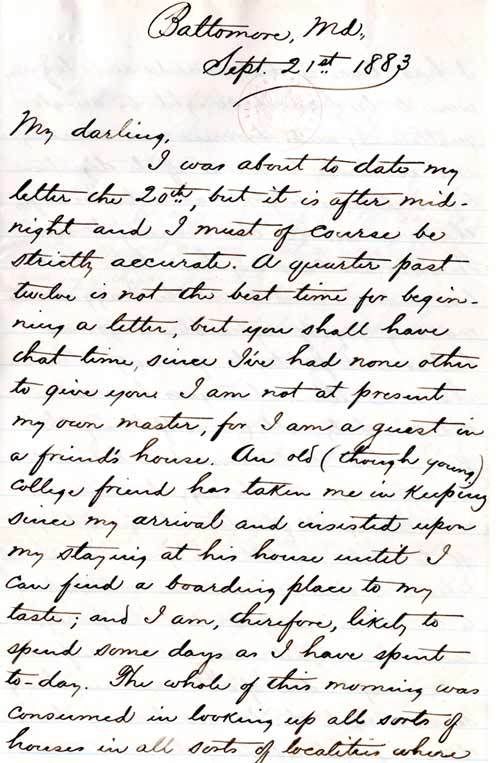
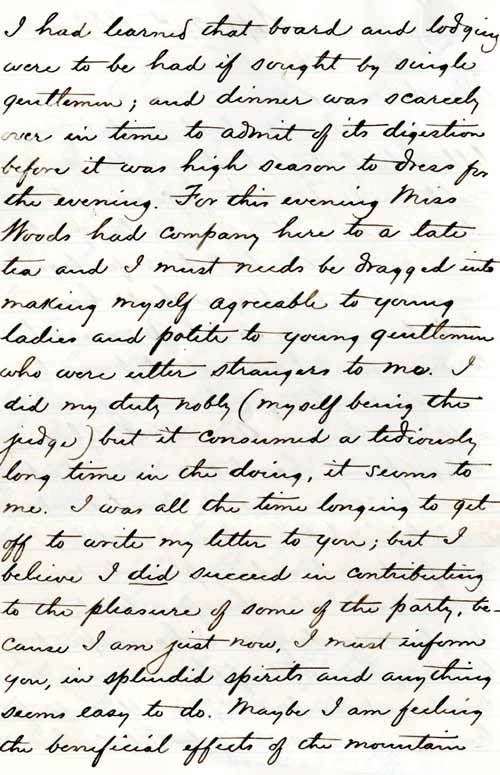
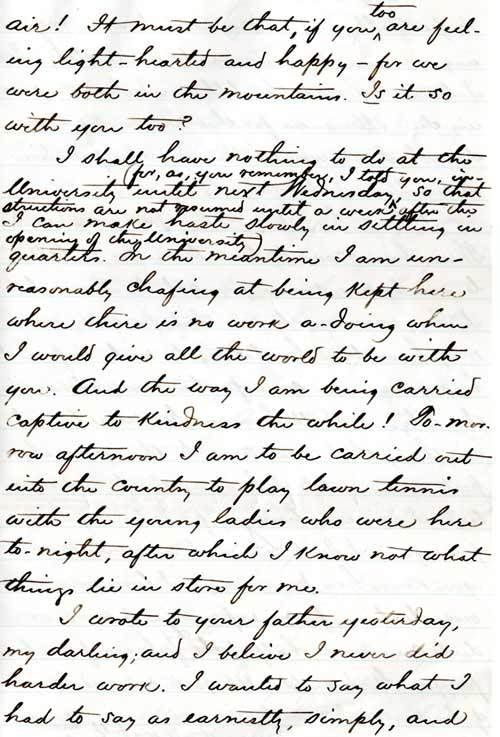
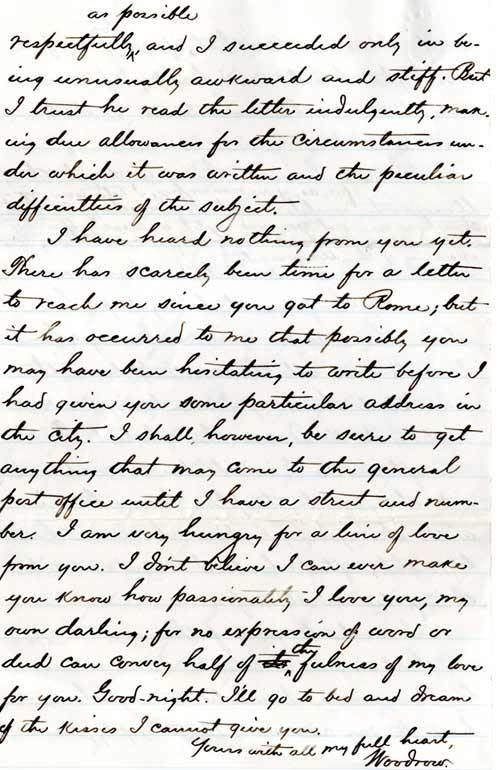
Letter 3
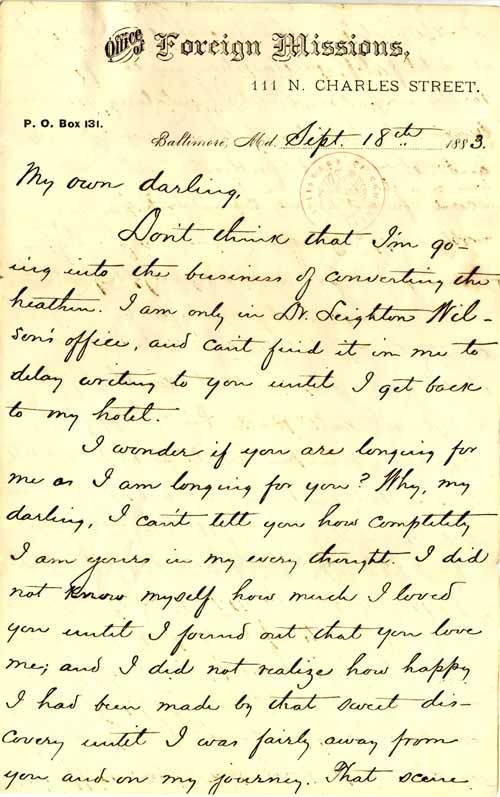
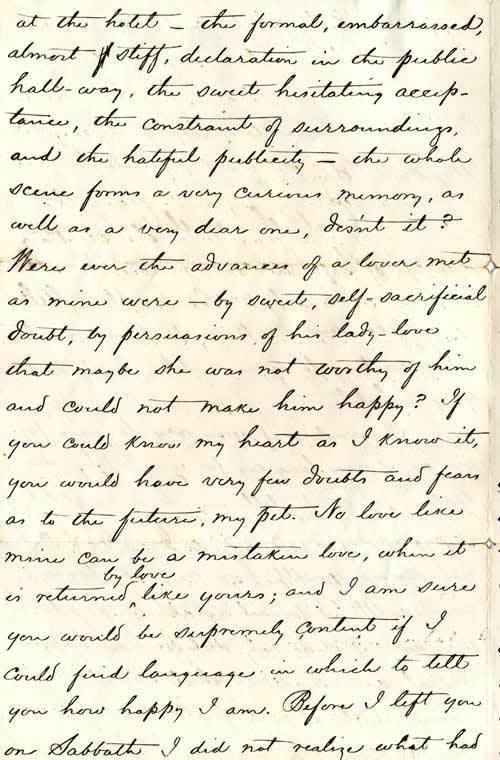

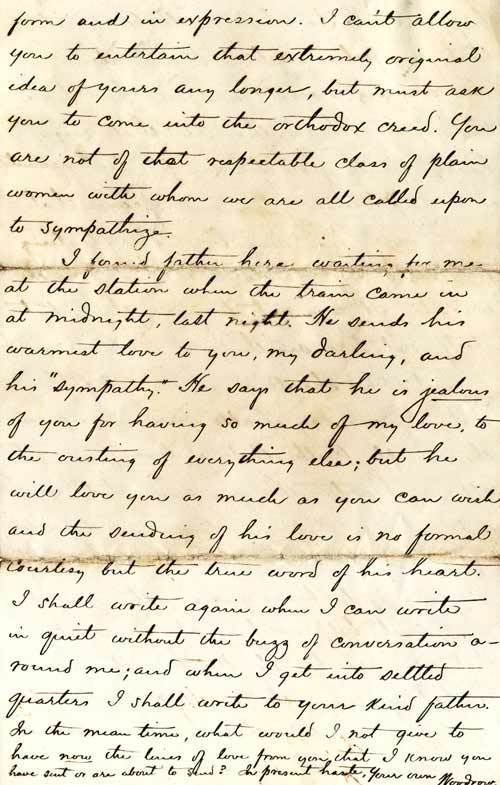
Letter 4
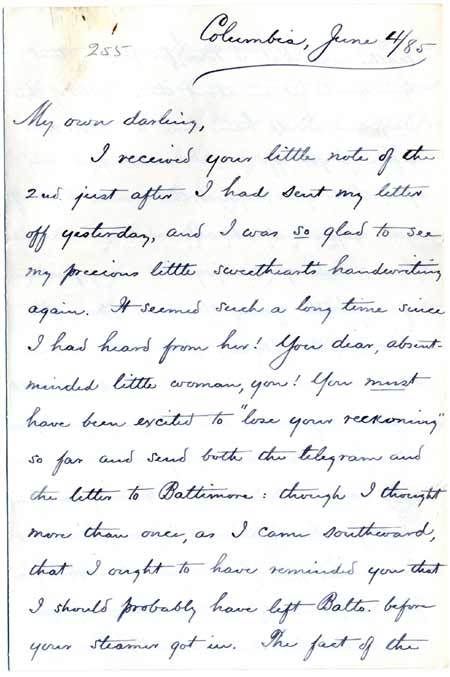

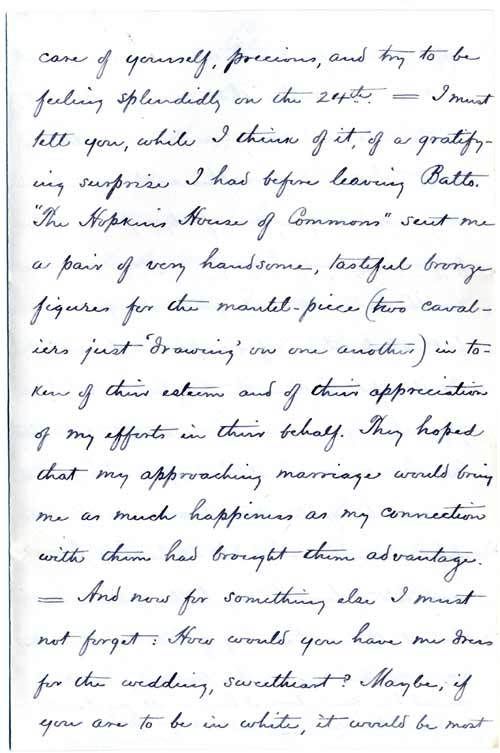
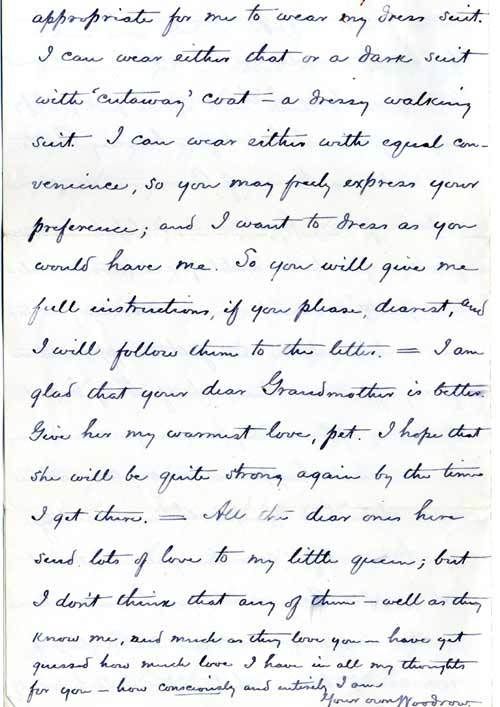
There are literally boxes and boxes of Woodrow Wilson's letters to his first wide in Mudd. Though obviously time cooled his ardent passion, it's clear that his love for her endured. I had typed up more commentary, but then I deleted it--Woodrow's letters speak for themselves. Make of them what you will.
All images are courtesy of the Seeley G. Mudd Manuscript Library. Any other use of these images requires written permission from the University Archives.
20 Sweet: Valentunes

Some people have been counting down the hours to Valentines Day since pre-Halloween, stocking up on those sugary hearts that say “Fax me,” or subtly leaving a florist’s phone number face-up in his or her significant other’s trashcan. For these folks, mushy love songs are everywhere, whether being played over grocery store soundsystems or sold on Valentines Day CDs at Starbucks. Another group of people feel only slightly excited for the supposed big day, but are more interested in simply letting their loved ones know how they feel—in a slightly less conventional way than playing “We Belong Together” by Mariah Carey. And then there is the third group left hanging out to dry: those brokenhearted or bitter souls who, if they could choose, would probably just skip straight from the 13th to the 15th. It is for these last two oft-ignored groups that I have created two separate Valentines Day playlists, along with a particularly memorable or unique lyric of choice from each of the songs. I hope that they make for a great 14th, no matter which group you fall into.
Unconventional Love Songs
1. “Everyday is a Holiday (With You)” – Esthero and Sean Lennon
-You're the crescendo to that melody, that melody I love
2. “She Moves in Her Own Way” – The Kooks
-I love her because she moves in her own way / She came to my show just to hear about my day
3. “Parentheses” – The Blow
- If something in the deli aisle makes you cry / Of course I’ll put my arm around you and walk you outside / Through the sliding doors, why would I mind?
4. “Caraluna” – Bacilos
-Mientras siga viendo tu cara en la cara de la luna / Mientras siga escuchando tu voz, entre las olas, entre la espuma
-Translation: While I keep on seeing your face in the moon’s face / While I keep on listening to your voice / Between the waves, between the foam
5. “Till Kingdom Come” – Coldplay
- For you I’d wait 'til kingdom come / Until my days, my days are done
6. “The Way I Am” – Ingrid Michaelson
- I'd buy you Rogaine when you start losing all your hair / Sew on patches to all you tear
Continued after the jump!
7. “5 Years” – Noah and the Whale
-Well I feel, oh, pretty happy too / And I’m always pretty happy when I’m just kicking back with you
8. “Oxygen” – Willy Mason
- I wanna be better than oxygen / So you can breathe when you're drowning and weak in the knees
9. “Anna Begins” – Counting Crows
- And every time she sneezes I believe it’s love
10. “My Favourite Book” – Stars
- I know your face / All the ways you move / You come in and I can read you / You’re my favourite book
Songs for the Brokenhearted/Bitter
1. “Woke Up New” – The Mountain Goats
- The first time I made coffee for just myself, I made too much of it / But I drank it all, just cause you hated when I let things go to waste
2. “F**k You” – Lily Allen
- Cause we hate what you do, and we hate your whole crew / So please don’t stay in touch
3. “Nothing Better” –The Postal Service
- Will someone please call a surgeon / Who can crack my ribs and repair this broken heart
4. “Gotta Have You” – The Weepies
-No amount of coffee, no amount of crying, no amount of whiskey, no amount of wine, no no no no no, nothing else will do, I gotta have you
5. “Merry Happy” – Kate Nash
-I can be alone, yeah / I can watch a sunset on my own
6. “Single Ladies (Put a Ring on It) – Beyoncé
-Cause you had your turn, and now you gonna learn / what it really feels like to miss me
7. “I’m Good, I’m Gone” – Lykke Li
- Well, say it now cause when I'm gone / You'll be calling but I won't be at the phone
8. “Smoke” – Ben Folds
- Leaf by leaf, page by page / Throw this book away / All the sadness, all the rage / Throw this book away
9. “Dry Your Eyes” – The Streets
- Dry your eyes mate / I know it's hard to take but her mind has been made up / There's plenty more fish in the sea
10. “Ain’t Nothin’ You Can Do” –Van Morrison
- When you’ve got a backache / Little rubbin’ will see you through / When you got a heartache / There ain't nothin' you can do
Cost of Tuition/year < Cost of inmate/year

Early Monday morning, I was in a cab with Professor Cornel West and Petey Greene student volunteers on our way to the Garden State Youth Correctional Facility in Bordentown, N.J. where he gave a speech to inmates in celebration of Black History month. While his message was positive and upbeat, the reality of the situation for the inmates, as we discussed on the ride over, is not.
Just browsing the NJ Department of Corrections (DOC) site, some stats:
Number of prisons in NJ operated by DOC: 14
Number of inmates in NJ prisons: ~23,000
Many of the inmates in the Garden State Correctional Facility were convicted of soft drug crimes and the former Educational Executive Director of NJDOC, Ike Ballard, said he believed politics was involved.
He explained that being caught selling drugs in a drug-free school zone guaranteed an automatic three year sentence. A zone is often designated as 50 yards around the schools and in urban areas where schools are close together, nearly every area is a drug-free zone. Additionally, the demographics in urban areas in comparison to suburban areas show that those convicted are more often likely to be individuals from low-income, minority backgrounds. Ballard said he wished the emphasis were treatment and not punishment because of the 60% recidivism rate (inmates returning to prison) in N.J.
--Tasnim Shamma '11
Tuesday, February 10, 2009
20 Sweet: Name Songs

For the first playlist of the “20 Sweet” series (in which we’ll give you a weekly playlist of 20 Sweet…whatever-we’re-in-the-mood-for-themed-songs), let’s begin with Name Songs. These 20 hail from a wide variety of genres, but they all have chosen a specific person to be the star of their lyrics.
Enjoy soaking up these 20 Sweet Name Songs, and feel free to comment if you would like to add to the list...who said there could only be 20?
1. “Valerie” – Mark Ronson feat. Amy Winehouse
2. “Alison” – Elvis Costello
3. “Zak and Sara” – Ben Folds
4. “Cecilia” – Simon & Garfunkel
5. “Son of Sam” –Elliott Smith
6. “Roxanne” – The Police
7. “Prescilla” – Bat for Lashes
8. “Lola” – The Kinks
9. “You Can Call Me Al” – Paul Simon
10. “Jimmy” – M.I.A.
11. “Jesse’s Girl” – Rick Springfield
12. “Camilo” – State Radio
13. “Gyasi Went Home” – Bedouin Soundclash
14. “Gloria” – Van Morrison
15. “Jane Fonda” – Mickey Avalon
16. “Tony the Beat” – The Sounds
17. “Eddie’s Ragga” – Spoon
18. “Come On Eileen” – Dexy’s Midnight Runners
19. “Jack and Dianne” – John Mellencamp
20. “Billie Jean” – Michael Jackson
Monday, February 9, 2009
Tiger Style: Warm Weather Transitions
In response to the unusually warm temperatures that blessed Princeton this weekend, students adapted by mixing wintry colors with more spring-like styles. Many broke out some fabulous coats, which had been forced to hide in the closet for the past two months. I especially liked the Strawberry Printed Jacket that Ariel Sibert’12 bought from a vintage store in L.A., and Mary Noble’s (Graduate student) white tufted coat from ebay. Boots were a necessity in such weather due to the slushy muck that destroys all flats with its filth. Some girls, however, braved the sludge wearing brightly colored sneakers in flat-out resistance to the season.

Scarf from Egypt
BCBG Sweater
Buffalo Jeans
Coach Shoes
Kenneth Cole Bag

Emma Yates '11
'TJ Maxx Scarf
U-Store Backpack
Jacket and Skirt from Nordstrom's
Italian Boots from 'TJ Maxx

Vintage Jacket
Vintage Skirt
Antique Key necklace
$4 Store Skirt
Buffalo Exchange Boots
Chanel Glasses
George Simmerton Coat
Urban Outfitters Sweater and Jeans
Boots from Paris
Flight 001 Bag

Hat from Austria
Scarf from China
Sweater from Germany
Check and Jones Jeans
Timberland Boots

Echo Red Coat
Backpack from a Luggage Store
Ruehl Jeans
Her own Boots

Vintage Coat from eBay

Macy's Leather Jacket

North Face Trench
Urban Outfitters Bag
Boots from Nordstroms
DKNY tights

Barbour Jacket
Polo Sweater
Citizen Jeans
Frye Boots
North Face Backpack

Fiona Chan'11
Tom Ford Sunglasses
Promod Skirt
Pepe Jeans Jacket
Benneton Shirt
Siegerson Morrison Boots
Wolford Tights
A Dilemma of Dining Decisions
Since it was published on Friday morning, Tasnim Shamma’s article “Insufficient aid deters sophomores from joining clubs” has attracted significant attention, receiving over 25 comments and topping the most-viewed and -commented articles lists for the ‘Prince.’ The article details the financial, and arguably socioeconomic, dimensions of decisions made by several juniors and sophomores to join eating clubs, join co-ops, join a four-year residential college or go independent. Essentially, many students are deterred from joining eating clubs by the clubs’ various fees – food, social, alcohol – and because, while the University’s financial aid partly covers the board component of juniors’ eating club expenses (currently, juniors and seniors on financial aid receive a board allowance equal to the average cost of an eating-club membership), students pay sophomore membership fees or social fees out of their own pockets. As a result, for some students joining an eating club “entails a lot of self-sacrifice and perhaps working more hours,” according to Qin Zhi Lau ’11.
In the comments section of the article, “TChen ’09” maintains that even “playing the aid-catchup game” would not eliminate the segregation of eating clubs, Spelman rooms and co-ops by “academic interest, racial and even geographic backgrounds,” and notes that many international students and students who are on full financial aid “would rather pocket the $2000” than pay eating club expenses. TChen also distinguishes sign-in eating clubs from bicker clubs, arguing that the latter’s Bicker “process force[s] bickerees to consider carefully what they want out of a Princeton social experience.” The poster adds that though some students find Bicker “confusing” or “unpleasant,” the selection process usually makes bicker clubs “ more cohesive and less segregated” than sign-in clubs and “provide[s] unparalleled ‘bonding experience[s]’ ” that cannot easily be achieved in four-year residential colleges, sign-in clubs or Spelman. By contrast, TChen argues that sign-in clubs “for many [are] a backup resort or because [those students] haven't thought about where they really want to be,” as evidenced by the high turnover rate in sign-in clubs. Furthermore, students on shared meal plans at sign-in clubs “don't really know what they want” but “don't want to miss out on this unique Princeton experience [of being in eating clubs] even though it's much more convenient/cheaper” to join four-year colleges.
Citing his own experience at Charter Club, “JTaggart ’09” refutes TChen’s contention that there is more social segregation in sign-in clubs than in bicker clubs, where one could argue that the Bicker process “can split up friends and create rivalries over control of the club, and who gets in.” JTaggart also maintains that TChen’s claim that some students go to sign-in clubs “by default” can be similarly applied to members of sports teams, fraternities and sororities that are affiliated with particular eating clubs.
Other comment authors do not distinguish between sign-in and bicker eating clubs in outlining the financial considerations associated with clubs. For instance, “Alum ’08” raises the question of whether it is responsible for students on financial to ask their parents to pay an extra $2,000 to $4,000 so they can join eating clubs if their families are “already struggling to get by paying for their kid's college education while saving up money for the next child's.” He also argues that the inability of some students’ families to pay the cost difference results in racial and socioeconomic segregation between the students who can afford eating clubs and those who cannot. Another complicating factor, “Alum ’06” says, is that with the expansion of upper-class dining alternatives, students can no longer make as cogent a case to their parents that they need to be in eating clubs and that their parents should therefore pay the clubs’ extra costs, even if these expenses would require “not … a little sacrifice.” In addition, “Observer” argues that the “stereotypical elitist reputation associated with the ‘eating clubs’ ” deters potential applicants and admitted students from applying to or attending Princeton. “’11” and “re: Bob Dog” note that not all the clubs publicize their costs.
“Teacher ’08” notes that each student must make a decision for himself regarding how much he values joining a club compared with how much he values one of the other upperclass dining options or the money he would save by not joining a club. Regular comment contributor “Crusty Alum” says he does not regret joining an eating club, adding that he personally found the extra loan debt he incurred from joining an eating club “to have been worthwhile.” While he notes that “as all things in life, [incurring such debt is] a choice and a sacrifice,” he does mention he wishes the University would “cover the last small difference” between total eating club fees and financial aid allowances. Re: Bob Dog also notes “the cost of being in a club is more than worth it,” and directs those who would find covering the cost of an eating club to speak with the financial aid office. Yet even increasing the financial aid package will not eliminate the cost gap between eating club fees and dining halls, co-ops or independent life, according to “Brown Senior.”
Finally, “’09” points out the inconsistency between club social fees not being covered by financial aid but social events at four-year residential colleges being covered by tuition, noting that the colleges are no less selective than sign-in clubs.
Have something to say about this topic? Please feel free to add to the comments section.
-Kelly Lack '10, Associate Editor for Research
Food Drive at Labyrinth Books
If you've been to Labyrinth lately to pick up books, you have probably seen the sign in the window advertising their ongoing food drive.
Labyrinth Books collects non-perishable goods and stores them for the food bank in Trenton, (which operates through the Trenton Crisis Ministry). On a weekly or bi-weekly basis, the Ministry picks up food donations.
If you are not familiar with New Jersey's geography, Trenton is only about fifteen minutes down Route 206, but its streets are starkly different from Princeton's. Given the recent fever pitch of the economic crisis, now is an especially important time to be aware of our neighbors.
If you're walking down Nassau Street sometime this week, pick up a can or two (the U-Store, Olive May's, CVS, McCaffery's, Wegman's and Whole Foods are a few local shops that sell non-perishables), and drop them off at Labyrinth.
If we come together as a campus and each donate two cans of food, this could make a massive difference for people suffering from difficult circumstances just a few miles away. Think about it this week.
Grade Deflation's Positive Effect - Better Grades for Tougher Courses

From the discussion in comments on the recent Prince story on how the growth rate of Princeton applications has slowed compared to Harvard and Yale, to discussions like these on College Confidential, (a site for students going through the college application process) the Princeton community seems to be raising the concern that grade deflation is causing a drop in application rates. Before the course enrollment period ends for this year, which is my last as an undergraduate at Princeton, I wanted to share the advice I give to any young student who asks about what courses to take, and how to build a successful academic record.
I believe that beyond the traditional arguments between more accurate standards and reducing job and graduate school prospects, Princeton's unique grade deflation policy has a major positive aspect: encouraging students to take more difficult undergraduate courses, and graduate courses. I base this argument on my personal experience and a story I wrote on grade deflation for the Prince after talking to Dean Malkiel and nearly every department head as a sophomore; I consider the grade deflation policy one of the few areas where I have more than usual expertise on Princeton academic life. Other columnists for the Prince have commented on some of the unforseen, and negative, effects of the policy as well.
Despite many students and professors who misconceive exactly how the policy works, grade deflation applies to departments as a whole, not to individual classes. Some students and professors -- mistakenly -- view the policy as a quota of 35% A-range grades that cannot be exceeded in each individual class. The policy actually sets 35% A-range grades as a target for departments as a whole, meaning that certain classes could have more or fewer than 35% A-range grades, but over the whole department, A's awarded should average out to the target of 35%.
As a practical result of the policy, departments often try to award fewer A-range grades in lower level and introductory courses (100-300 level, for example), and award more A-range grades in higher-level courses (400 level, for example). To cite a specific case, as I understand it, the "mathematical track" of ECO 310, 311, and 312 in the Economics Department awards a higher percentage of A's than the non-mathematical track of core courses ECO 300, 301, and 302. This differential, if I understand it correctly, (and please correct me in an e-mail or the comments if my knowledge of the department's policy is out-of-date) is certainly fair and understandable: a student challenging him or her self in the more difficult course could drop down to the easier one and earn a higher grade, so he or she should not be punished (in terms of grading) for taking the more difficult course.
Because the grade deflation policy applies to departments as a whole, departments have an incentive to save higher grades for more difficult courses, to avoid penalizing students who choose to take the tougher course. As a result, the grade deflation policy has the commendable effect of encouraging students to take tougher courses.
Additionally, the graduate school at Princeton does not have a grade deflation policy. As a result, professors in graduate courses are not buffeted by a downward pressure on grades. Students who take tougher courses, in this case at the graduate level, are rewarded for challenging themselves with better grades if they do the work thoroughly.
Regardless of the contentious (and necessary) broader debate over the impact of the grade deflation policy on applications to Princeton or the job market, the grade deflation policy does have the positive effect of encouraging students to take more difficult courses. As a result, this is my advice to young students currently shopping classes: take that 400 or 500 level course, you will be rewarded for challenging yourself!
Sunday, February 8, 2009
Figures of the Speech: The New Wave

One week into the new semester and campus is already awash with lectures, seminars, and meetings for all interests. Here are a few stand-outs from the lecture line-up for this week:
“Global Health: Sierra Leone’s Classroom” on Monday February 9, 4:30 in Dodds Auditorium– Part movie, part lecture, this event sponsored by the Woodrow Wilson School features the premier of the documentary “Pride of Lions,” which tells the story of survivors of war in Sierra Leone, and a lecture by Dan Kelly ’03, the Founder and Executive Director of the Global Action Foundation, an organization which focuses on treatment for amputees. Go for the free food; stay for the warm and fuzzy feeling that people can still do good things in the world.
“Call+Response Screening and Panel” on Tuesday February 10, 4:30 screening and 6:00 panel in McCosh 50 – This is might be the one you stand in line for. The film, “Call+Response,” a critically acclaimed documentary about the plight of 27 million slaves around the world and the state of the modern abolition movement, will be screened first, followed by an expert panel featuring Professor Cornel West and the film’s director, Justin Dillon. Go for Cornel West; stay because you have to wonder, “27 million? How is that even possible?”
“National Teach-In on Climate Change” on Wednesday February 11, 4:30 in Robertson Bowl 001—I know everyone says that they are experts on climate change, but these people actually are. Rather than focus on obscure scientific minutiae or sweeping policy changes, this event breaks climate change down into three key topics: Economic Implications and the Role of Government, Media and Climate Change, and Climate Change and Global Development. Go for a crash course in the many ways in which climate change is rocking our world, and stay for Jon Braman, Ukulele-rapper extraordinaire. Yea, I said ukulele-rapper. Beat that.
Thursday, February 5, 2009
Belated but still timely review of "Milk"
The other day, I entered Small World Coffee to have my soy latte fix, only to spot Alison Pill (the actress in ‘Milk’ who plays the lesbian Anne Kronenberg active in Harvey Milk’s campaign) relaxing with a coffee in hand and a Labyrinth bag leaning against her extended calf. I could not contain myself any longer. I had to know. I approached her, and found that she was a pleasant and charmingly awkward individual. She helped me confirm my longstanding belief: Gus Van Sant was an amazing director.
Many consider Van Sant to be the auteur of our time, versed with a distinctive perspective that caters to an esoteric, arthouse audience while still able to traverse the gap into the mainstream Hollywood arena. With the biopic ‘Milk’, the acclaimed director of Oscar winning ‘Good Will Hunting’ and ‘Elephant’, has delivered another tour de force.
It is not difficult to compare Van Sant’s efforts in supplying a forceful dent to the perceptions of conventional society with Harvey Milk’s own achievements. It is also inevitable, post-Prop 8, to regard the film ‘Milk’ as an invigorating stimulation for the gay community enraged by the de-evolution of human progress and acceptance in California. ‘Milk’ is thus, not only a reenactment of an individual’s life, but also a political beacon, the torch whose display of splendor does not disappoint. The awards and nominations it has garnered so far can attest to that.
The opening scenes of the film set the tone, where Harvey Milk (Sean Penn in another astounding performance) picks up Scott Smith (James Franco) in a subway station to avoid spending another birthday alone. They spend the night at Milk’s and formulate a new resolution: to move to San Francisco, make a difference in the gay community, and peel away from the confines of the closet.
‘Milk’ is very much a collaborative effort between director and ensemble performers. Penn, in a role that requires a 180 degree turn from his award-winning Byronic character in ‘Mystic River’, portrays a flamboyantly vociferous figure to perfection. Playing a distraught and neglected ‘housewife’, Franco withdraws from the comfort zone once again and absolutely delivers. Supplement this with Emile Hirsch’s ex-gigolo turned aid, and the cast is unbeatable. Even the ever chameleon-like Josh Brolin, last seen in Oliver Stone’s ‘W.’ and ‘No Country for Old Men’, was able to pull off a disappointingly flat character and transform it into an individual wrought with insecurities and anger.
The extensive interpolation of conventional film, Super-8 film and archival, 60s footage provides a congenial quality that reminds one of neglected memories, of lost childhood, love and encounters. One of the strongest moments in the film is when the camera zooms out of Penn and Franco locked in an intimate and passionate kiss, by a sign stating ‘we are open’ in reference to their newly opened camera shop, unafraid of outsider persecution. The moment grainy quality that seems to capture fragility and nostalgia of the time.
Ten years down the road however, this film will likely be forgotten because it falls victim to its own forceful message. It is so oversaturated with gay rights themes that after 2 hours of repetition, the characters and voice of the film become quite one-dimensional. At times it seems like we were watching a crusader movie. Even Dan White’s already underdeveloped motive for killing Milk and the Mayor George Mascone, is overshadowed by the dominant spirit of gay activism. While the film flimsily suggests White’s homosexual tendencies, it felt inadequate. Perhaps a double bill in the vein of the ‘Flag of Our Fathers’ and ‘Letters from Iwo Jima’ is needed to expound the interesting background of White’s emotional and psychological turmoil.
Nonetheless, while it lasts, ‘Milk’ is an epic effort by the maverick Gus Van Sant, and would definitely collect many awards come Oscar day.
Paws: Four our of Five
Pros: Great acting, distinctive filmmaking and beautifully filmed scenes.
Cons: Over-saturation of gay rights theme gets tedious after 2 hours.
Trailer: http://www.youtube.com/watch?v=unu-9vM9VZw
Wednesday, February 4, 2009
Stimulus Debate: Princeton economists speak out on both sides
At right, the TED Spread, further below, the unemployment rate.
For those of you, like me, who constantly refresh economics blogs and keep yourselves up to date on the TED Spread (an important indicator of credit liquidity; the difference between interest rates on interbank loans and treasury bills) and unemployment , or for those of you who have less interest in finance but are working for Hedge Funds next year anyway (you know who you are!), Princeton's best economists are weighing in on both sides of the debate over the economic stimulus plan currently stalled in the Senate.
Recent Nobel laureate and professor Paul Krugman weighs in regularly on his New York Times blog, "Conscience of a Liberal," where he supports a robust fiscal stimulus plan that focuses on infrastructure investment rather than tax cuts. Krugman's posts are a mixture of arguments intended for laymen, and more "wonkish" posts on technical economics.
Harvard Professor and Class of 1980 graduate N. Gregory Mankiw expresses more skepticism of the plan moving through Congress, with posts on the "Problem of Hasty Public Investment," and whether the package is "Temporary, Targeted, and Timely."
Professor and former Vice Chairman of the Federal Reserve Alan Blinder writes regularly for the New York Times on the financial side of the crisis, discussing the mistakes that got the nation where it is today, and debates the stimulus in a lengthy podcast on NPR.
Of course, former Professor Ben Bernanke continues to lead the Federal Reserve's response to the crisis, and spoke earlier in January summarizing the Fed's bold new programs and his view of the necessary steps to continue responding.
Paul Volcker, of the class of 1949, has been working in government economic policy for more than 50 years, and helped quell inflation as the Federal Reserve chairman in the early 1980s. He's back in the center of economic policy in the White House, working on plans for greater regulation of the financial system.
Tuesday, February 3, 2009
Figures of Speech: Brian's Last Edition

Unfortunately, it’s too late to post about a speech that happened Monday afternoon with noted Lincoln scholar Michael Burlingame. Regardless, here’s this week’s rundown.
The Can’t Miss:
Chairman of the Joint Chiefs of Staff Mike Mullen; Thursday at 4:30 in McCosh 10; “Global Trends and National Security.”
In case you’ve been under a rock for the last three months, or for that matter the past two years, there’s a new administration in Washington, which means a new foreign policy. Admiral Mullen, of course, is not a political appointee (I really hope I didn’t have to point that one out), but he is presumably one part of any military decision President Obama will make. And it’s not everyday you hear the Chairman of the Joint Chiefs speak on campus, either.
Writer George Packer; Thursday at 8:00 in McCosh 50; “The New Liberalism.”
This Thursday when it rains, it pours. Packer is the author of “The Assassins’ Gate: America in Iraq.” He is a well-regarded liberal writer who has been an opponent of the Iraq War despite supporting it initially. Packer writes for the New Yorker.
Professor Charles Seife ’93 of NYU; Wednesday at 4:15 in Gottlieb at the Princeton Plasma Physics Laboratory; “Fusion, Politics, and the Press.”
If you have the wherewithal to make it to the PPPL, you might consider flooring the (particle) accelerator and going to hear Professor Seife. We urge you not to break the (cosmic) speed limit, though. Seife is a science writer and a professor of journalism at NYU. He is also a Princeton alum. His most recent work is “Sun in a Bottle: The Strange History of Fusion and the Science of Wishful Thinking.” If you go, be sure to stop at the bakery for some yellowcake on the way home.
Nothing quite like my bad science jokes.
This is Brian's final "Figures of Speech" post.
Monday, February 2, 2009
Caffeine Fix

We sell this stuff at the C-Store.
Amongst the Pepto and Nyquil required to recover from your basic college aches and pains, I saw for the first time today a box of caffeine pills called No Doz. Upon further research, there doesn't seem to be anything particularly wrong with the caffeine pills. Half to one whole pill is equivalent to a cup of coffee, (or probably a Yerba Maté at Café Viv). Side effects can include nausea, dizziness, nervousness, and irritability. Additionally, too much caffeine can irritate the stomach lining and cause increased urination.
Bicker in perspective - History, Analysis, Statistics
 For everyone going through the stressful process of Bicker around now, or interested in learning more, I went back through the Prince archives to find some facts, figures, and stories about one of Princeton's most unique and controversial social institutions.
For everyone going through the stressful process of Bicker around now, or interested in learning more, I went back through the Prince archives to find some facts, figures, and stories about one of Princeton's most unique and controversial social institutions.
Our most recent and thorough reporting on the Bicker process came in an excellent 2006 series by Regina Lee and Sophia Dwosh.
The stories first run through what bicker is like at each of the five clubs.
Dwosh and Lee turn to a historical retrospective of the Bicker system, which involved weeks-long "calling periods" in dorm rooms, protests by sophomores, and lawsuits to allow Women into Ivy, Cottage, and T.I. Although the process of Bicker has been criticized for excluding certain student groups, an article from sixty years ago demonstrates that times have changed for the better:
"Identification of a candidate as a Jew, or from an old Baltimore family, as a Chinese or a Negro or as a member of any special group by accident of birth receives consideration by bicker-men," David Lewit '47 wrote in a 1949 article entitled "The Motivations of Bicker Men."Bicker clubs' selectivity has fallen in the past 3 years from a peak in 2005, although Ivy and Tower rejected more than 40% of applicants last year, as the graph below shows:
Graph of club selectivity by percentage rejected over time (1998-2008):

Turning to today and the future, the Bicker system and eating clubs as a whole must compete with newly renovated dining halls and residential colleges, offering an attractive alternative with good food to the clubs. Last year, however, clubs increased their membership over 2006, which is expected given the growing size of each Princeton class, but shows that the addition of residential colleges has not caused a precipitous drop in students choosing clubs, either bicker or sign-in:
Graph of new club members by club, 2008:

